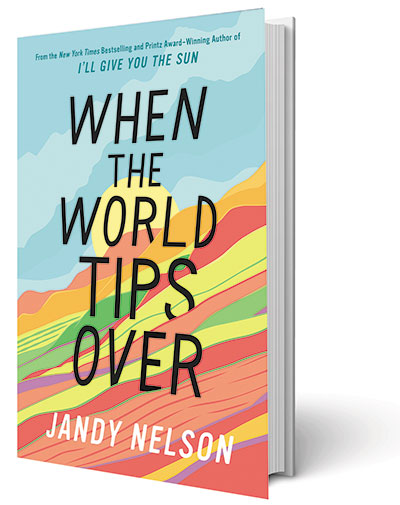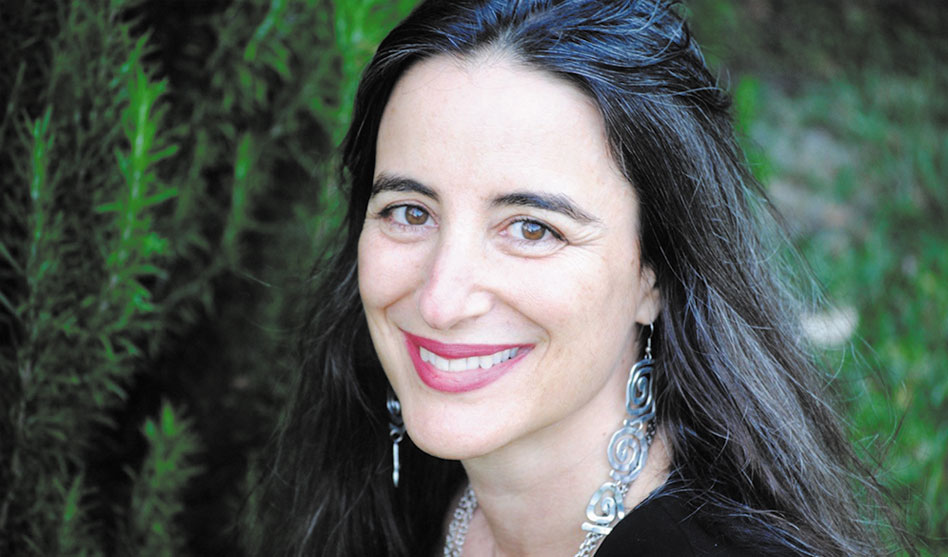Jandy Nelson (Photo by Sonya Sones)
Award winning author
Jandy Nelson returns with first novel in 10 years
MELISSA WHITLER | NBCU Fellow
Melissa@DallasVoice.com
Jandy Nelson, bestselling author of I’ll Give You the Sun, is back with a new novel, When the World Tips Over, publishing Sept 24. She weaves a beautiful tale of the Fall family and their generational curse. Readers will get lost in the lives of Dizzy, Miles and Wynton Falls as they work through their own pains and the legacy that has been passed down to them.
 The three siblings aren’t able to communicate with one another until rainbow-haired Cassidy falls into their lives. She becomes a savior in more ways than one, unraveling a history spanning centuries.
The three siblings aren’t able to communicate with one another until rainbow-haired Cassidy falls into their lives. She becomes a savior in more ways than one, unraveling a history spanning centuries.
Before the book’s release, Nelson met with Dallas Voice to discuss her writing and inspiration.
Dallas Voice: How does it feel to have your first book released in 10 years? Jandy Nelson: I’m like Rip Van Winkle waking from a hundred-year sleep! It feels amazing! I couldn’t be more excited for this passionate, unwieldy crew of characters to hit the world. They’re almost more real to me at this point than my actual family, and I can’t wait for readers to finally meet them and go with them on what I hope will be a pretty wild adventure.
Where did you come up with the idea for When the World Tips Over? It all started with an abandoned house. For years, I’d travel north from San Francisco, through wine-country, and I’d pass this white Victorian tucked away in the redwoods by a creek. It seemed enchanted to me, and I was totally mesmerized by it. Each time I’d drive by, I’d stop and tromp around, peek in the windows, sit on the porch.And soon I began imagining a family — the Falls.
The front door would blow open, and I’d see 19-year-old human-minefield Wynton Fall, violin in hand. Or I’d catch a glimpse through the second-story window of 17-year Miles Fall, brainiac, dog whisperer and raving beauty harboring a multitude of secrets. Or I’d spot through the kitchen window 12-year-old Dizzy Fall, pulling a chocolate-raspberry soufflé out of the oven, a wild commotion of a girl who sees spirits and wants to be the heroine of a romance novel.
And then, as time passed, I started imagining the previous generations of this same family that lived in the house, finally wondering who built the house and where did they come from? What were they running from? Were they cultural pioneers that came to Northern California from Europe at the turn of last century to create a kind of queer dream life for themselves? I decided they were.
But I didn’t begin the novel in earnest until a rainbow-haired girl showed up in my mind and began knocking at the front door of the brewing story. I knew who she was and that everything was about to change for the family.
I dropped the big white house into dreamy half-magical Paradise Springs, a fictional Northern California wine town, and 10 years later, here we are!
But the strangest part of this origin story is that recently I drove north, and the house was gone! If I hadn’t taken a ton of pictures, I’d almost think I imagined it. Now, I just think maybe it left the real world to live forever in this fictional one.
You deal with many different topics like generational trauma, coming out, family relationships and mental health. What draws you to these, and how do you write about them in such a real, authentic way? First, thank you! I’m so happy it feels real and authentic. I spend a great deal of time getting to know my characters, really trying to live in their skin. So I hope to come at whatever issues they’re dealing with from the inside out, whether it’s their own troubled mental landscape or their sexuality or whatever struggles and triumphs, joys and sorrows, that make them who they are.
Some of my characters’ issues are my issues or the issues of people close to me, but many aren’t. And in that case, I do a lot of research and then set out to utterly lose myself inside the characters until I feel capable of speaking for them from a place of authenticity.
More generally, I absolutely adore both reading and writing novels about families. I feel like every family is its own civilization with its own pathos and ethos, its own laws, rules, language, humor. Each is its own unique dramatic and/or comedic pressure-cooker, and that’s just perfect fodder for storytelling.
Also, because When the World Tips Over is a multi-generational family saga, for the first time I really got to explore all sorts of intergenerational issues that fascinate me — how the past shapes the present; how trauma as well as joy are passed down; how choices of relatives made a hundred or fifty or 20 years ago still affect us today, and, most important, how harmful generation patterns, once understood, can be broken.
All your books have very distinct, colorful covers. How did you decide on the cover designs? I have such an amazing cover designer: Theresa Evangelista. She makes magic! The one thing I asked for with both I’ll Give You the Sun and
When the World Tips Over was bright color. I had a feeling when finishing both novels that, by the end, the characters had really begun to break free of societal, familial and personal constraints, and, to me, all the amazing color reflects that personal liberation.
When The World Tips Over goes through many different POVs as well as jumping back and forth between the past and present. How did you keep track of it all? Honestly, no idea! It’s definitely a kaleidoscopic novel, a chorus of voices, really four novels in one. In early drafts, I wrote some of the narrative threads separately: the ancestral fairy tale, the mother/daughter story and the Fall siblings’ mother’s story that reveals her past. And then I spent years and several million brain cells (it was tough!) braiding them all together with the contemporary story of the Fall siblings.
I worked tirelessly on the structure because I knew it was all one story and desperately wanted all the narrative threads to flow together into one cohesive whole. At one point, the novel was over a thousand pages! It’s half that now.
Where did the inspiration for the character Cassidy come from? Cassidy was one of those characters that arrived almost fully formed, as if she’d been living inside me for a very long time, waiting for a chance to tell her story. Same with her mother, Marigold. When I was in my 20s, I read a bunch of mother/daughter novels and loved them: Anywhere But Here by Mona Simpson, Ghost Dance by Carol Maso, for instance. Cassidy and Marigold gave me a chance to do my own, a very extreme version: a renegade mother and daughter who live in an RV, perpetually searching for a California town to settle down in, much like the pioneers a century before them, caught up in their own unique version of the California dream/nightmare.
Music is a very important element of the book. What song would you say describes the novel? Two come to mind: “California Dreamin” by the Mamas and the Papas and “Invisible String” by Taylor Swift.
What do you want readers to walk away with from this novel? I just hope readers enjoy the story and the characters, and I guess, walk away — preferably float away, actually — with a full heart and a hungry belly, perhaps thinking about what I was thinking about while writing it: that safe harbor is found in other people, that joys are sometimes hidden away in sorrows, that splendor is everywhere, and soufflés are the most heavenly food on earth, bar none.
Did it feel different writing this book from your other two? It did feel different. It was more difficult, and I’ll Give You the Sun was very challenging for me. But I also really loved writing this novel so much — maybe even more than the others — because it’s everything I ever wanted to write packed into one story. My whole heart’s in there. It’s a multi-generational family saga. It’s a story of a mother and daughter who live in an RV at the edge of the world. And it’s also a fairy tale, a food memoir (aphrodisiacal soufflés!), a scrapbook, a ghost story, a love letter to California and an ode to storytelling itself. It’s full of family curses, rivalries, road trips and love stories upon love stories upon love stories.
It’s a lot a lot a lot!
The book incorporates some elements of magic realism. How did you decide what supernatural elements to add while still keeping the story relatable and grounded in reality? Are you saying your dog doesn’t talk to you!? In my mind, in the novel, there are two kinds of magic realism or fabulism. The first is one of perception which stems from a character’s deep psychological need. For example, Miles’s ability to speak with his dog.
I think/hope this type of supernatural element feels grounded in the story because as a reader you’re inside the character’s POV and it makes sense to the character. (An aside: I also wrote this novel during the pandemic when I was very isolated and spending too much time with my cat! So, there’s that.)
And I think it’s similar with Dizzy’s ability to see spirits. She never questions it because it jives with her world view.
The other kind of fabulism in the novel is the fairy tale told by one character to another about the family’s ancestors. That story is outright magical, full of men who float and others who glow; women who have flowers growing out of their heads, and giants who eat houses. I wanted to tell the family’s ancestral story this way because I think we all tend to mythologize the past. Perhaps that’s why the novel might still feel grounded with this utterly magical story in it — because we all kind of naturally partake in mythological perception/recollection of the past, don’t we? The impulse is just wildly exaggerated here. And it was so fun to write!

